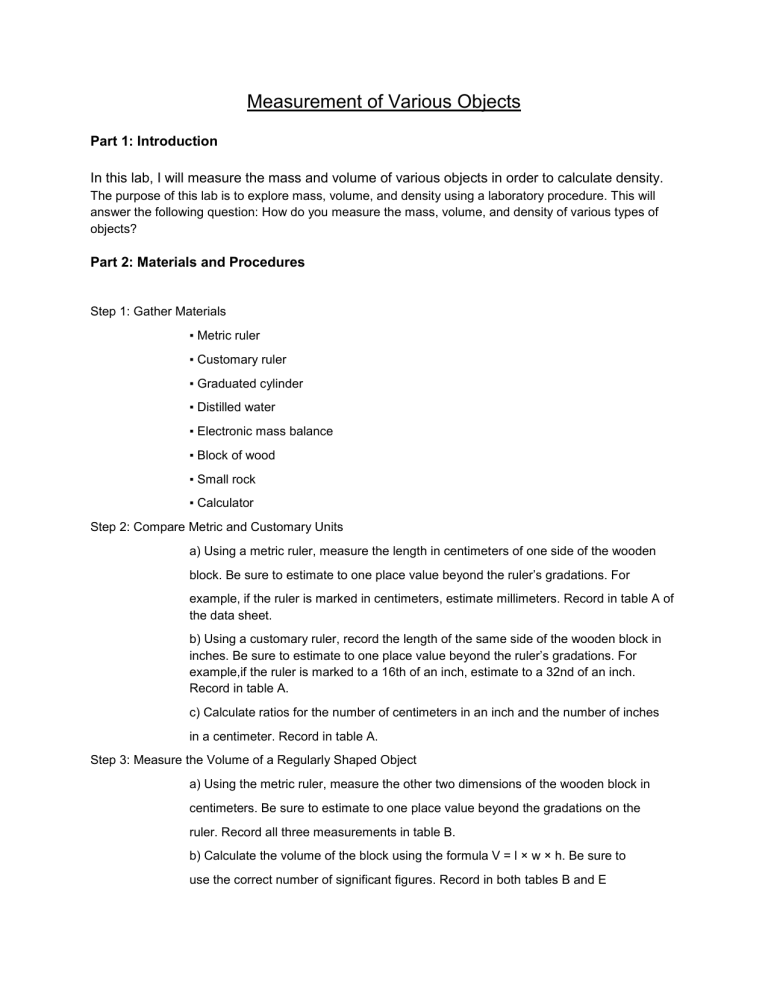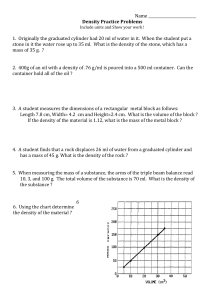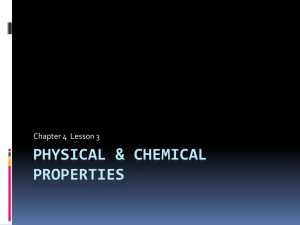
Measurement of Various Objects Part 1: Introduction In this lab, I will measure the mass and volume of various objects in order to calculate density. The purpose of this lab is to explore mass, volume, and density using a laboratory procedure. This will answer the following question: How do you measure the mass, volume, and density of various types of objects? Part 2: Materials and Procedures Step 1: Gather Materials ▪ Metric ruler ▪ Customary ruler ▪ Graduated cylinder ▪ Distilled water ▪ Electronic mass balance ▪ Block of wood ▪ Small rock ▪ Calculator Step 2: Compare Metric and Customary Units a) Using a metric ruler, measure the length in centimeters of one side of the wooden block. Be sure to estimate to one place value beyond the ruler’s gradations. For example, if the ruler is marked in centimeters, estimate millimeters. Record in table A of the data sheet. b) Using a customary ruler, record the length of the same side of the wooden block in inches. Be sure to estimate to one place value beyond the ruler’s gradations. For example,if the ruler is marked to a 16th of an inch, estimate to a 32nd of an inch. Record in table A. c) Calculate ratios for the number of centimeters in an inch and the number of inches in a centimeter. Record in table A. Step 3: Measure the Volume of a Regularly Shaped Object a) Using the metric ruler, measure the other two dimensions of the wooden block in centimeters. Be sure to estimate to one place value beyond the gradations on the ruler. Record all three measurements in table B. b) Calculate the volume of the block using the formula V = l × w × h. Be sure to use the correct number of significant figures. Record in both tables B and E Step 4: Measure the Mass of a Solid a) Tare the balance. Place the wooden block on the pan, and record the block’s mass in grams in table E. b) Tare the balance again. Place the rock on the pan, and record the rock’s mass in table E. Step 5: Measure the Mass of a Liquid a) Tare the balance. Record the mass of the graduated cylinder (with air in it) in table C. b) Remove the cylinder from the balance, and fill it approximately halfway with distilled water. c) Tare the balance again. Record the combined mass of the cylinder and water in table C. d) Find the mass of the water using subtraction. Record the result in tables C and E. Save the cylinder and water for steps 6 and 7. Step 6: Measure the Volume of a Liquid Place the graduated cylinder from step 5 on a flat surface. View the meniscus at eye level.(The meniscus is the curve that forms at the top of the water in the graduated cylinder.)Measure the volume of water in mL at the bottom of the meniscus, and record in tables D and E. Step 7: Measure the Volume of an Irregularly Shaped Object a) Gently add the rock to the water in the graduated cylinder from steps 5 and 6, taking care to avoid spills. Make sure the rock is fully submerged in the water. b) Record the combined volume of the water and rock in table D. c) Calculate the volume of the rock by subtracting the volume of the water from the volume of the rock and water. Note the change of unit from mL to cm3 because 1 mL = 1 cm3. Record the result in the tables D and E. Step 8: Calculate Density Density is defined by the equation d = m/v. Calculate the density of the wooden block, the rock,and the water by dividing the mass of each object by its volume. Record the density (g /cm3) for each object in table D. Step 9: Dispose of all materials according to the directions of your teacher. Part 3: Data Part 4: Conclusion In this experiment, we found the density of 3 objects by measuring mass and volume. The rock was the most dense with a density of _________. This means that the atoms are more tightly packed together than in the other objects.




